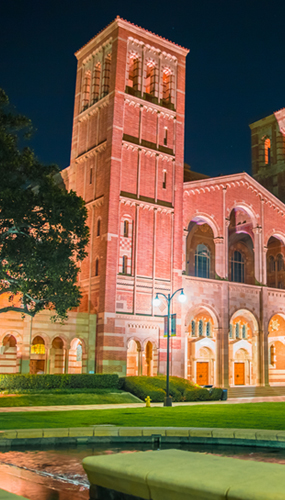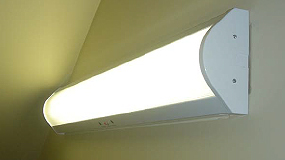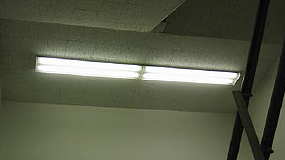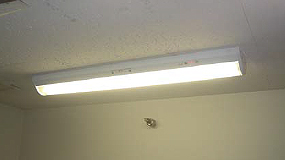Lamar LED Case Study:
Public Interest Energy Research Program: Bi-Level Stairwell Lighting System

“We are seeing significant energy savings, particularly during off-peak periods or when building occupancy is low.”
Jack Powazek—Facilities Management, UCLA
PIER Buildings Program | Research Powers the Future | www.energy.ca.gov/pier
Energy Savings Opportunity
Better light, safety, energy savings, upkeep, payback
Stairwell lighting typically operates continuously at full output despite very low, intermittent use. Simple occupancy sensors are not used due to building code requirements that prohibit zero light levels even when unoccupied.
A bi-level product line demonstrated by the New York State Energy Research and Development Agency (NYSERDA) and the PIER Program uses an ultrasonic occupancy sensor to detect motion in areas like stairwells and corridors. During unoccupied periods, the lamps are dimmed to as low as 5% of normal. An adjustable timedelay can be used to maximize energy savings based on usage patterns. Currently, the Uniform Building Code requires minimal lighting of one foot-candle (fc) for emergency egress in all stairwells. The National Fire Protection Association (NFPA) has already adopted a new minimum illuminance level of 10 fc during all occupied times. Though this code change will take till perhaps 2007 or 2008 to be universally adopted, this bi-level fixture is code compliant far in advance while still saving a great deal of energy.

Field Demonstrations UC and CSU Campuses
The bi-level fixtures were installed at the University of California Office of the President (UCOP), UC Los Angeles, UC Santa Barbara, UC Irvine, UC Riverside, Sonoma State University, CSU Northridge, and San Diego State University. Average fixture savings was approximately $50 per year.
Product Overview
Energy Savings:
- Up to 70% annual energy savings depending on occupancy
- Over typical fixture life of 20 years, one fixture can save more than 10,000 kWh
Operation/Maintenance:
- Cost effective replacement for moderate to low occupancy areas. Increased lamp life due to “lamp conditioning circuit” and programmed start dimming ballast
Manufacturer:
- LAMAR LED
Market:
- Stairwells, hallways, storerooms, restrooms
Availability:
- Currently available from LAMAR LED
Lessons Learned
- Stairwells with occupancy rates of 15% or less are the most cost effective applications. However, averaging the occupancy rates of multiple stairwells in multiple buildings is a recommended practice.
- If an application is over-lit, the total number of lamps/ fixtures may be reduced due to the high system efficacy.
- Building codes may require stairwell fixtures to have emergency battery backups, an option in these fixtures.
- No problems occurred unless the fixtures were improperly grounded or the installer did not utilize the “lamp conditioning mechanism” as instructed.
CPUC Partnership
The University of California/California State University (UC/CSU) and Investor-Owned Utility (IOU) Partnership Program has identified incentives for this technology that range from $90 to $120 per fixture. For more information please visit: www.uccsuiouee.org.
Installation Costs
Retrofit:
The installation/disposal labor cost for complete fixture replacement depends on the contractors’ assignment of personnel. One electrician is capable of installing this fixture. It may be appropriate for one electrician and one assistant to perform the installation. Locations with T12, HID, or incandescent fixtures are best for retrofit. Fixture cost was $150 without battery backup which was an additional $65.
New Construction:
Payback in new construction is much shorter than in retrofit applications since labor costs are equivalent to those for other standard fixtures. Complete renovation projects yield equally brief payback periods.
Payback for UC/CSU campuses with CPUC Incentives
Study Results
Retrofit Paybacks (7.5% Occupancy)
New Construction Paybacks (7.5% Occupancy)
Considerations
Ease of Installation:
Typical installation time is less than an hour, usually a one-to-one swap. Often able to use existing wall/ceiling mount hardware.
Issues/Concerns:
The manufacturer has noted that the only problems with these fixtures have been related to installation, improper wiring, or forgetting to trigger the “lamp conditioning circuit” which is critical for ensuring longer lamp life.
Attractiveness:
All campus users noted much improved light quality and brightness when occupied.
Conclusion
About PIER
This project was conducted by the California Energy Commission’s Public Interest Energy Research (PIER) program. PIER supports public-interest energy research and development that helps improve the quality of life in California by bringing environmentally safe, affordable, and reliable energy services and products to the marketplace.
Cost Effectiveness:
Cost effective for retrofit, remodeling, and especially new construction applications. Programmed start ballast and special “lamp conditioning circuit” increase lamp life and reduce maintenance. Best retrofit paybacks are for replacing incandescent fixtures or T12 fluorescent fixtures.
Potential Impact:
Drastically reduced average fixture wattage. Huge energy savings for new construction and retrofit applications. Reduces peak demand. Attractive option for tall buildings and low traffic stairwells.
Applicability:
Primarily stairwell and hallway applications. May be used in parking structures and bathrooms.
Considerations:
Improved lighting quality, easy to install, easy to clean.
Availability:
The LAMAR LED Occusmart VOL Series bi-level stairwell fixture is currently available from LAMAR LED. There are multiple fixture types in this series.


